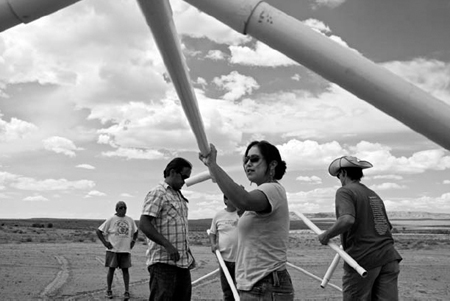The Next Eco-Warriors (8 page)
Read The Next Eco-Warriors Online
Authors: Emily Hunter

On January 1, 2006, due to the work of many Native and non-Native individuals and organizations, the mine, the pipeline, and the power plant all closed. It was a bittersweet victory, however; jobs and tribal income would be lost. Like weeds in a freshly watered and tended garden, new coal proposals began popping up as solutions to this Navajo economic “crisis.” It was no time to celebrate. I felt a crushing weight; we had helped do this, we had helped take away some of the few jobs on the rez and spur new desperate coal proposals. If we were ever going to be welcomed back to the community without side glares and distrust, we were going to have to do more. Our communities deserve a fair and just economic transition. Our work continued.
_________
ALMOST FOUR YEARS AFTER THE BLACK MESA mine had been shut down and numerous restarts have failed, I found myself in the summer of 2009 sitting in the visitors' section of our tribal council chambers. It was the second day of the Navajo Nation Council summer legislative session, our government's Senate. I was in Window Rock, Arizona, for the Navajo Green Jobs vote.
As with my many other visits to our tribal nation's capitol, I tried to calm my urge to leave this place and head home, back to my children. I had spent the past four years of my daughter's life dragging her to public hearings, community meetings, and board meetings or leaving her at home with my sister. I longed to be home with my children, enjoying picking corn or feeding
the chickens. I must remind myself that those wanted simplicities are the reason I am here today.
Black Mesa Water Coalition has grown up since the CPUC hearing. And as the codirector, I'd learned many lessons, most of them the hard way. Reprimanded or embarrassed by elders in the community over and over again, I learned there are times when you should not sit back and just watch the debate and other times when you have to shut up and listen, listen, listen, and you better know how to tell when is when. I had to partially unlearn my whole way of thinking that I received from college and relearn how to see myself as a part of everything around me. Every day is a constant melding of two worldviews: individualism versus communalism.
Our group itself had spent the past years in coalition with many other groups advocating for a just transition off coal dependence and on to green jobs. For us, green jobs mean good-paying jobs that don't pollute. They also mean more than cloaking a broken capitalist system in a sexy green dress. The green economy we propose would enable local Navajo communities to have jobs which are not only sustainable, but also utilize our traditional skills and knowledge.
That day, the Navajo Nation Council, with all its
Robert's Rules of Order
and formalities, was once again considering our proposal, the “Navajo Nation Green Economy Commission and Fund.” This was more than bureaucratic political process; if the delegates supported this legislation, it would be the first step toward creating thousands of new, nonpolluting jobs on the reservation. The Commission and Fund would amass funding to provide communities with business and technical support. It would grant funds for job creation in everything from agriculture and green building initiatives to solar and wind community co-ops, as well as training programs for workforce development and management. It all boiled down to this.
We'd been to our capitol too many times to count, but that day was going to be different. We filled the visitors' section with green shirts and stickers. There were even some among the council delegates and staffers. Everything read N
AVAJO
G
REEN
J
OBS
N
OW!
I tried to look calm and composed while sweating in the July heat. My fingers blazed along my phone's tiny computer screen as I sent out emails and texts to volunteers and staff here and at our office.
Finally the session started. The Speaker of the council entered the room. My dear friend and codirector, Wahleah Johns, and my clan brother, Tony Skrelunas, had been asked to join the Speaker to answer any delegate's questions. As they made their way to the front of the room, I could hardly contain my anticipation.
Before questions, the secretary read the legislation. As each line of the legislation was read, I thought about the almost two years we worked with just about everyone to build a policy that reflected the wide-ranging needs of a Navajo green economy. My mind flashed back to our first meeting with the Navajo legislative lawyer; on first sight, her only comment was, “You are going to need some older people with you.” We were, for the most part, a group of people in our twenties and thirties, and that worried some. Legislative processes after all don't normally see many people under the age of fifty head-butting their way into policy shifts. But it's my future and my children's future that politicians are screwing with. Every day they are making decisions on things that will affect us far into the future. So there we were again, a group of young people, filling the Navajo Nation Council with green, letting our council know that we were watching their decision. And at that moment, across the country, Navajo college students and those working in cities were faxing, emailing, and calling their council delegate, letting them know that they were watching as well.
Green jobs mean good-paying jobs that don't pollute. They also mean more than cloaking a broken capitalist system in a sexy green dress. The green economy we propose would enable local Navajo communities to have jobs which are not only sustainable, but also utilize our traditional skills and knowledge
.
Then before I knew it, the motion was made in Navajo to close discussion and vote. My breath caught as I turned my eyes up to watch the large electronic scoreboard that hangs above the chambers and dangled our fate. Each delegate's name appeared with a red or green light next to it to indicate his or her vote. Green, green, green, green, red, green. ... The seconds seemed like
minutes, waiting for each to vote. But then there it was, the decision—62 to 1—it passed! For a second I looked around me, wondering to myself,
did it really just pass?
Anxious faces turned to huge smiles; we all jumped up and cheered. In this rural part of Arizona, the capitol of our Nation, where dirt roads are more abundant than paved ones and politics has often followed an unwavering commitment to coal and gas, this small victory felt like being at the center of a major seismic event.
_________
NOW, SITTING AT THE KITCHEN TABLE —LAPTOP OPEN; dishes piling up; in between juggling phone calls, emails, and kid's meals—I think about how far we have come. And yet, there is still so much work to be done: a need for multiangled and multistakeholder campaigns, a need to build equity on the same “green” side. Black Mesa is still being mined today for coal, with numerous proposals igniting to reopen the closed parts. I remind myself that change is happening step by step. I have proudly stood side by side with so many courageous people as we are called idealists, radicals, or inexperienced young people. I realize it is we—the young, idealistic radicals—who are not only demanding but also building some of the wisest solutions in our communities.
One of the biggest honors I have received in my life was being asked to present at my old high school's Career Day. This community, which for so long has been sustained by the coal mine, dealt with mine layoffs, and received mine payoffs, asked me to speak, and I went. I worried I might need a bulletproof vest, but instead I was greeted with open arms and smiles. Everyone seemed eager to talk about the positive changes the community is making now, and rather than being constantly challenged, I was treated with respect and appreciation. It was these subtle exchanges that were some of the highest acknowledgments and rewards for me. Looking back now, I know that some of the hardest and most heartwarming work to do is in our own communities. It is the tough and scary work of challenging our own family, friends, and people we've grown up with and daring them to dream bigger than we've ever been taught.
Some of the hardest and most heartwarming work to do is in our own communities. It is the tough and scary work of challenging our own family, friends, and people we've grown up with and daring them to dream bigger than we've ever been taught
.
Peabody's lights still blink over Black Mesa, but one day soon they will be turned off, and, shining brightly, the moon and stars will remain. The stories, values, and teachings embedded within the night sky remain alive, and we must remember them as we reshape the world we want to see.
_________
Enei Begaye stepped down from directing the Black Mesa Water Coalition to make room for younger leadership, but she remains a senior advisor and active member. She is currently living in Alaska with her husband, Evon Peter, who is also a strong advocate within Alaska Native communities. Enei is enjoying time with their four children, strategizing on campaigns, and writing her reflections on the past ten years of community organizing on the reservation
.

PHOTO BY AARONHUEY
 Twenty-five
Twenty-five United States
United States Climate Comedian
Climate Comedian

PHOTO BY STEFFEN THALEMANN
